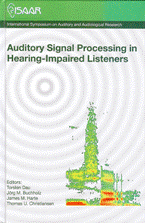Do hearing-impaired listeners benefit from spatial and temporal cues in a complex auditory scene?
Abstract
In auditory scenes containing many similar sound sources, difficulties with the detection and organization of acoustic information can lead to disruptions in the identification of behaviorally relevant targets. A previous study conducted in young normal-hearing listeners (Best et al., 2007) investigated the benefit of providing simple visual cues for when and/or where a target string of spoken digits would occur in a complex acoustic mixture. Importantly, the visual cues provided no information about the target content. A visual cue indicating which loudspeaker (from an array of five) would contain the target improved accuracy, and a cue indicating which time segment (out of a possible five) would contain the target resulted in a smaller improvement. The present study extended this work to young listeners with sensorineural hearing loss. These listeners performed more poorly overall than the normal-hearing group, but did benefit from visual cues indicating where and when to listen for the target. While the magnitude of the temporal cue benefit was comparable between groups, the spatial cue benefit was smaller on average for the hearing impaired listeners. This result suggests that one component of the difficulties experienced by listeners with hearing loss in complex tasks of this nature is related to directing spatial attention.
References
Best, V., Ozmeral, E. J., and Shinn-Cunningham, B. G. (2007). “Visually-guided attention enhances target identification in a complex auditory scene,” J. Assoc. Res. Otolaryng., 8, 294-304.
Bronkhorst, A. W. and Plomp, R. (1992). “Effect of multiple speechlike maskers on binaural speech recognition in normal and impaired hearing,” J. Acoust. Soc. Am., 92, 3132-3139.
Brungart, D. S., Simpson, B. D., Ericson, M. A., and Scott, K. R. (2001). “Informational and energetic masking effects in the perception of multiple simultaneous talkers,” J. Acoust. Soc. Am., 110, 2527–2538.
Cooke, M. (2006). “A glimpsing model of speech perception in noise,” J. Acoust. Soc. Am., 119, 1562-1573.
Duquesnoy, A. J. (1983). “Effect of a single interfering noise or speech source upon the binaural sentence intelligibility of aged persons,” J. Acoust. Soc. Am., 74, 739-743.
Ericson, M. A., Brungart, D. S., and Simpson, B. D. (2004). “Factors that influence intelligibility in multitalker speech displays,” Int. J. Aviation Psych., 14, 311-332.
Festen, J. M. and Plomp, R. (1990). “Effects of fluctuating noise and interfering speech on the speech-reception threshold for impaired and normal hearing,” J. Acoust. Soc. Am., 88, 1725-1736.
Freyman, R. L., Balakrishnan, U., and Helfer, K. S. (2001). ”Spatial release from informational masking in speech recognition,” J. Acoust. Soc. Am., 109, 2112-2122.
Gatehouse S. and Noble, W. (2004). “The speech, spatial and qualities of hearing scale (SSQ),” Int. J. Audiol., 43, 85-99.
Grose, J. H., Hall, J. W. III. (1992). “Comodulation masking release for speech stimuli,” J. Acoust. Soc. Am., 91, 1042-1050.
Kidd, G. J., Arbogast, T. L, Mason, C. R., and Gallun, F. J. (2005). “The advantage of knowing where to listen,” J. Acoust. Soc. Am., 118, 3804-3815.
Lorenzi, C., Gilbert, G., Carn, H., Garnier, S., and Moore, B. C. J. (2006). “Speech perception problems of the hearing impaired reflect inability to use temporal fine structure," PNAS, 103, 18866-18869.
Zurek, P. M. (1993). “Binaural advantages and directional effects in speech intelligibility,” In: Acoustical Factors Affecting Hearing Aid Performance, edited by G. A. Studebaker and I. Hochberg. Allyn and Bacon, Boston.
Additional Files
Published
How to Cite
Issue
Section
License
Authors who publish with this journal agree to the following terms:
a. Authors retain copyright* and grant the journal right of first publication with the work simultaneously licensed under a Creative Commons Attribution License that allows others to share the work with an acknowledgement of the work's authorship and initial publication in this journal.
b. Authors are able to enter into separate, additional contractual arrangements for the non-exclusive distribution of the journal's published version of the work (e.g., post it to an institutional repository or publish it in a book), with an acknowledgement of its initial publication in this journal.
c. Authors are permitted and encouraged to post their work online (e.g., in institutional repositories or on their website) prior to and during the submission process, as it can lead to productive exchanges, as well as earlier and greater citation of published work (See The Effect of Open Access).
*From the 2017 issue onward. The Danavox Jubilee Foundation owns the copyright of all articles published in the 1969-2015 issues. However, authors are still allowed to share the work with an acknowledgement of the work's authorship and initial publication in this journal.


